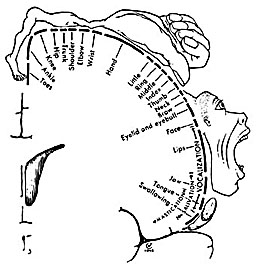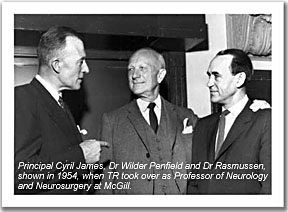 |
"Motor homunculus" from Penfield and Rasmussen
The Cerebral Cortex of Man
(1950)
|
|
McGill and Chicago
For the next two years he was
Assistant Neurosurgeon and Lecturer in Neurology
and Neurosurgery at McGill, during which time he
worked on the detailed analyses of cortical localization of
sensory, motor and speech function in four hundred patients
on whom brain mapping had been carried out as part
of the surgical treatment of epilepsy. The
resulting monograph by Penfield and Rasmussen, The
Cerebral Cortex of Man, published in 1950, became one of
the classical references in this field. It included
extensive maps of the sensory and motor cortex and, derived
from those, new versions of the familiar homunculus.
In 1947 Dr Rasmussen was appointed
Professor of Neurological Surgery at the University of Chicago.
Here he initiated a project using radioactive yttrium to
deliver beta-radiation to ablate the pituitary gland to
treat patients with metastatic cancer. He and his father
also notably reported on the histology of the pituitary
gland of "Bushman", a 500-lb gorilla from the Lincoln
Park Zoo who had succumbed to a strange peripheral neuropathy.
|
|
In 1954 Dr Rasmussen became
Professor and Chairman of Neurology and Neurosurgery at
McGill and when Wilder Penfield retired in 1960, Rasmussen
succeeded him as Director of the Montreal Neurological
Institute. He also served as Neurologist and
Neurosurgeon-in-Chief of the Royal Victoria Hospital. In
1963, in response to provincial legislation, the Montreal
Neurological Hospital was constituted, legally separating
the hospital from the teaching and research institute;
Rasmussen thus took on the title of the first
Director-General. He efficiently administered the Institute,
Hospital and Department from 1954 to 1972 in a well-ordered
and evenhanded manner; during that same time he continued in
active surgical practice. |
 |
|